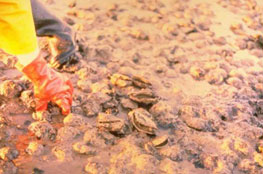Diseases of molluscs
Parasitic diseases—Infection with Bonamia ostreae
CLICK ON IMAGE TO ENLARGE

Source: D Alderman
Signs of disease
Important: animals with disease may show one or more of the signs below, but disease may still be present in the absence of any signs.
Diseases resulting from any of the Bonamia species are remarkably similar, in that few or no clinical or gross signs are present with light infection. Differentiation of the causative agent requires histological laboratory examination.
The occasional visible cues with heavy infection include:
Clinical signs of disease in an infected animal
- generally poor condition
- gaping oysters
Gross signs of disease in an infected animal
- yellow discolouration and perforated ulcers in the connective tissue of gills, mantle and digestive gland
Disease agent
Bonamia spp, including B. ostreae, are protists (intrahaemocytic protozoa) of the phylum Haplosporidia that cause lethal infection of the haemocytes of certain oysters.
Bonamia infection in oysters rarely results in clinical signs of disease. More often, the only visual cue is increased mortality.
Host range
Molluscs known to be susceptible to infection with B. ostreae:
European flat oyster* (Ostrea edulis)
Olympia oyster* (Ostrea conchaphila)
Argentian flat oyster (Ostrea puelchana)
Asiatic oyster (Ostrea denselammellosa)
New Zealand dredge oyster (Ostrea chilensis)
southern mud oyster (Ostrea angasi)
Suminoe oyster (Crassostrea ariakensis)
* naturally susceptible (other species have been shown to be experimentally susceptible)
Presence in Asia–Pacific
EXOTIC — has not been officially reported in the Asia–Pacific region under the NACA–FAO–OIE quarterly aquatic animal disease reporting program.
Epidemiology
- The critical age for development of disease appears to be two years.
- Significant mortalities usually occur at water temperatures of 12°–20°C.
- Systemic infection of haemocytes effectively starves the oyster of energy required for survival. As it fights the infection, the animal eventually dies from exhaustion and starvation.
- The disease can occur at any time of the year, although the prevalence and intensity of infection increase during the warmer months. In the Northern Hemisphere, prevalence is highest in September.
- The pre-patent period is up to five months.
- The disease is thought to have spread from California and through Europe mainly because of human movement of infected oysters.
Differential diagnosis
The differential diagnostic table and the list of similar diseases appearing at the bottom of each disease page refer only to the diseases covered by this field guide. Gross signs observed might well be representative of a wider range of diseases not included here. Therefore, these diagnostic aids should not be read as a guide to a definitive diagnosis, but rather as a tool to help identify the listed diseases that most closely account for the gross signs.
Similar diseases
Infection with Bonamia exitiosa.
Sample collection
Because of uncertainty in differentiating diseases using only gross signs, and because some aquatic animal disease agents might pose a risk to humans, you should not try to collect samples unless you have been trained. Instead, you should phone your national hotline number and report your observations. If samples have to be collected, the agency taking the call will advise you on what you need to do. Local or district fisheries/veterinary authorities could advise you on sampling.
Emergency disease hotline
For your national emergency disease hotline number, see Whom to contact if you suspect a disease.
Further reading
http://www.oie.int/aac/eng/cards/en_diseasecard.htm
http://www.pac.dfo-mpo.gc.ca/sci/shelldis/pages/bonostoy_e.htm
The currently accepted procedures for a conclusive diagnosis of infection with Bonamia ostreae are summarised at http://www.oie.int/eng/normes/fmanual/A_00037.htm
These hyperlinks were correct and functioning at the time of publication.

